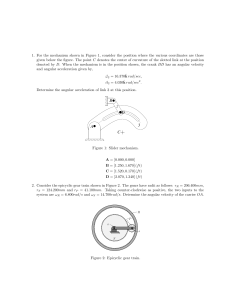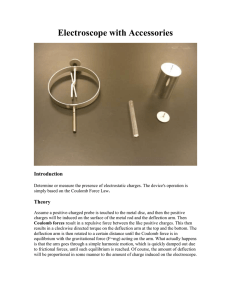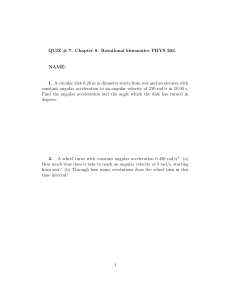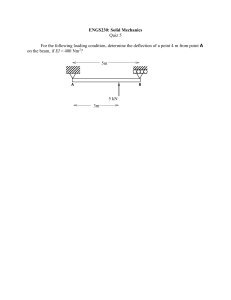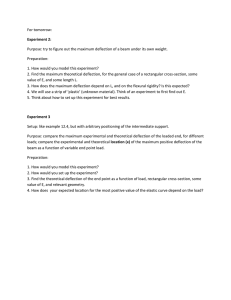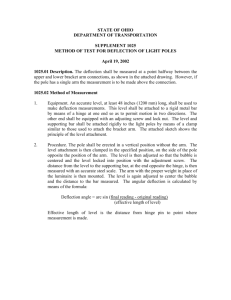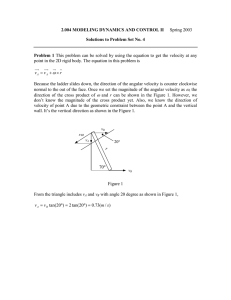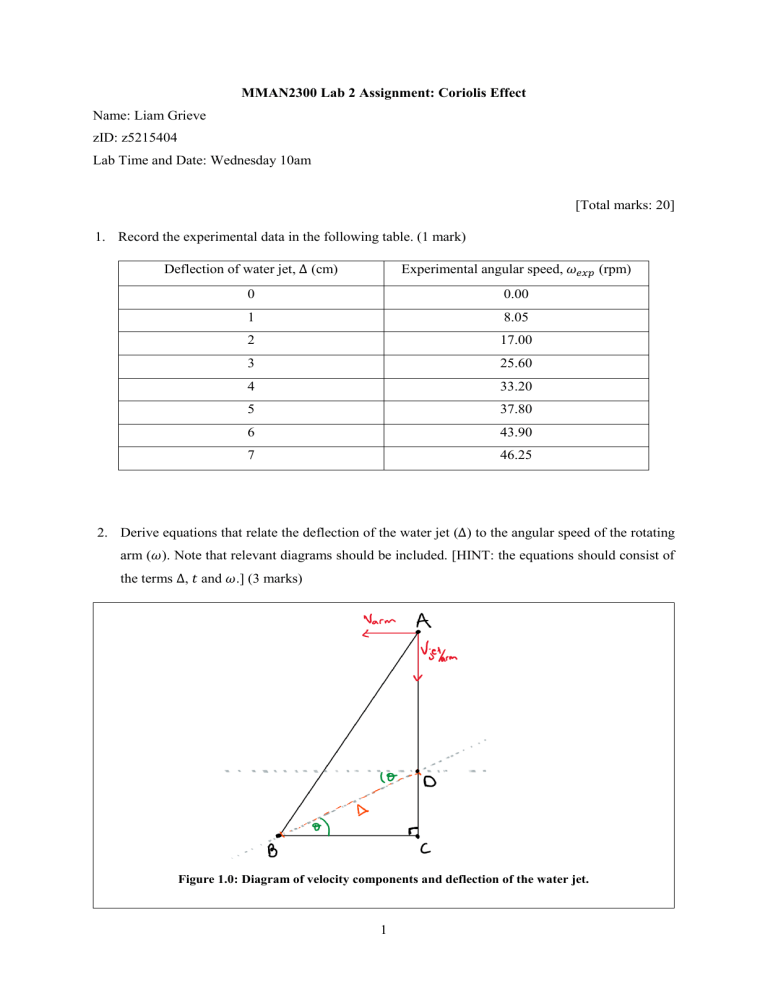
MMAN2300 Lab 2 Assignment: Coriolis Effect Name: Liam Grieve zID: z5215404 Lab Time and Date: Wednesday 10am [Total marks: 20] 1. Record the experimental data in the following table. (1 mark) Deflection of water jet, Δ (cm) Experimental angular speed, 𝜔𝑒𝑥𝑝 (rpm) 0 0.00 1 8.05 2 17.00 3 25.60 4 33.20 5 37.80 6 43.90 7 46.25 2. Derive equations that relate the deflection of the water jet (Δ) to the angular speed of the rotating arm (𝜔). Note that relevant diagrams should be included. [HINT: the equations should consist of the terms Δ, 𝑡 and 𝜔.] (3 marks) Figure 1.0: Diagram of velocity components and deflection of the water jet. 1 The following are standard equations that describe the velocity if the arm and water jet as well as the angular velocity 𝑣𝑗𝑒𝑡⁄ = 𝑎𝑟𝑚 𝐹𝑙𝑜𝑤 𝑅𝑎𝑡𝑒 𝑄 = 𝐴𝑟𝑒𝑎 𝑜𝑓 𝑁𝑜𝑧𝑧𝑙𝑒 𝐴 𝑣𝑎𝑟𝑚 = 𝑅 ⋅ 𝜔 𝜔= 𝜃 𝑡 (1.1) (1.2) (1.3) Since the disk is moving in a circular motion the velocity of water particles leaving the nozzle have both tangential and normal components. Radial: ̅̅̅̅ 𝐴𝐶 𝑎𝑟𝑚 𝑡 𝑅 + Δ sin(θ) = 𝑡 𝑅 + Δ sin(θ) 𝑡= 𝑣𝑗𝑒𝑡⁄ 𝑣𝑗𝑒𝑡⁄ = (1.4) 𝑎𝑟𝑚 Tangential: ̅̅̅̅ 𝐵𝐶 𝑡 Δ sin(θ) 𝑅⋅𝜔 = 𝑡 𝑅 ⋅ 𝜃 Δ cos(θ) = 𝑡 𝑡 𝑣𝑎𝑟𝑚 = 𝑅 ⋅ 𝜃 = Δ cos(θ) 𝜃= Δ cos(θ) 𝑅 (1.5) Combining the radial and tangential components and dividing equation 1.5 by 1.4 produces the following equation. Hence, forming a relationship between Δ and 𝜔. 𝜔= 𝑣𝑗𝑒𝑡⁄ 𝜃 Δ cos(θ) 𝑎𝑟𝑚 = ⋅ 𝑡 𝑅 𝑅 + Δ sin(θ) 2 (1.6) 3. For a flow rate of 0.35 L/min as mentioned in the Lab Handout, calculate the velocity of the water jet relative to the rotating arm. The distance between the nozzle tip of the pump and the centre of rotation is 134 mm and the internal diameter of the nozzle is 2 mm. (1 mark) 𝑣𝑗𝑒𝑡⁄ 𝑎𝑟𝑚 = 𝐹𝑙𝑜𝑤 𝑅𝑎𝑡𝑒 𝑄 = 𝐴𝑟𝑒𝑎 𝑜𝑓 𝑁𝑜𝑧𝑧𝑙𝑒 𝐴 0.00035 60 = 2 2 ⋅ 10−3 𝜋⋅( 2 ) = 1.8568 m/s 4. Calculate the theoretical values of 𝑡 and 𝜔 for the given Δ values below using the equations derived in Q2 and fill in the following table. (3 marks) Deflection of water jet, Time taken to reach the wall, Theoretical angular speed, Δ (cm) 𝑡 (s) 𝜔𝑡ℎ𝑒𝑜 (rad/s) 0 0 0 1 0.072567 1.02553 2 0.073751 2.00172 3 0.075670 2.88825 4 0.078251 3.65936 5 0.081412 4.30468 6 0.085064 4.82639 7 0.089124 5.23486 3 5. Plot the theoretical and experimental angular speeds (𝜔𝑡ℎ𝑒𝑜 and 𝜔𝑒𝑥𝑝 in rad/s) against deflection (Δ in cm) in one graph. (2 marks) Figure 2.0: Theoretical vs Experimental Angular Speeds. 6. Calculate the percentage error between the theoretical and experimental angular speeds. (2 marks) Deflection of water jet, Theoretical angular Experimental angular Δ (cm) speed, 𝜔𝑡ℎ𝑒𝑜 (rad/s) speed, 𝜔𝑒𝑥𝑝 (rad/s) 0 0 0 ~ 1 1.02553 0.84299 17.79 2 2.00172 1.78023 11.06 3 2.88825 2.68082 7.18 4 3.65936 3.47669 4.99 5 4.30468 3.95840 8.04 6 4.82639 4.59719 4.74 7 5.23486 4.84328 7.48 4 Percentage Error (%) 7. Write a discussion here. (6 marks) The following aspects should be considered: a. Comment on the effect of angular speed of the rotating arm and its direction on the deflection of the water jet. b. Compare the theoretical and experimental values and discuss the results. c. Identify the sources of errors. Your answer should not exceed 1.5 page. This laboratory was effective at investigating the link between the speed of rotating arm and the direction and magnitude of deflection that the stream underwent. It is clear from figure 2.0 in part five that relationship between the deflection of the water stream and the angular velocity of the arm is exponential. An interesting point to note is the trend of both the experimental and theoretical data to plateau out as the angular velocity of the arm is increased, this is due to the nature of the stream under experimental conditions. A further point to note is that when the direction of the arm’s angular velocity was reversed the angular deflection also changed. Comparing both the experimental and theoretical results calculated for this laboratory, it is apparent that the theoretical angular velocity required to achieve a certain deflection distance is consistently larger that the experimental results. These inconstancies are the results of error caused by the equipment and methods of data collection. The two main sources of this error were caused by parallax and the uneven flow rate of the water. Parallax errors were caused by the spinning of arm, where the scale was mounted. This caused the viewing angle to be at an oblique angle with respect to the deflection scale, thus making the impact point of the water stream appear to be in a different position to what it was. A further point of inaccuracies arose from the fact that the water stream splayed out upon hitting the wall. This made the recording of results significantly harder as it was near impossible to accurately determine exactly where stream was hitting the scale. Both factors were further compounded as the rpm was increase, however, the errors were able to be slightly mitigated by repeating the experiment multiple times to establish an average. A further error was caused by inconsistencies in the flow rate. As the stream was not flowing with constant velocity there was a fluctuation in the results. If the flow rate was greater than expected, then the time taken for the water to reach the scale was lower, resulting in less deflection for a given angular velocity of the arm. Similarly, if the flow rate of the water is lower than expected the time taken to hit the scale will be longer than expected and thus the deflection will be greater. A strange 5 phenomenon observed in this experimental setup is the behaviour of the water stream whilst the arm was rotating clockwise. In this case the fluctuation in the flow rate was so great that no data points were calculated under these conditions. Finally, calibrating the flow rate by making stream hit a certain point whilst the arm was stationary may have caused some error. These things considered, the laboratory still managed to demonstrate that as the angular speed of the arm was increased so did the deflection of the water jet. 8. Draw a conclusion by summarising the key findings of this experiment and recommendations to improve the experiment. (2 marks) This laboratory demonstrated that as the angular speed of the arm was increased the deflection of the water jet also increased. If this laboratory was to be repeated, I would recommend the instillation of a recording device mounted on the arm and facing towards the scale. This would remove the error caused be parallax and speed up the time it took to record data. Furthermore, I would also recommend using a pump that could maintain a consistence flow rate in both counter clockwise and clockwise directions. These two additions would greatly reduce error and data gathering time. 6 References [Optional] 7

